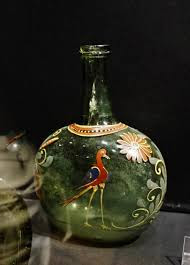In the fall of 1240, Baty launched a siege of Kyiv.
The Tatar-Mongols settled down against the walls of the city in a huge, noisy
camp. They burned bonfires, sang riotous songs, danced ... Kyiv heard the
neighing of horses, the clang of weapons, the roar of camels.
The townspeople said goodbye to each other, waiting
for death. And so, on one cloudy December day, Baty launched an assault on
Kyiv... The majestic capital of Rus turned into ruins. The city seemed to have
died out, subsided, the few surviving from the Tatar robbery were hiding in the
forests. Among them were glass masters. Their property was looted. But they
carried away with them talented hands and an inventive mind. And this turned
out to be not so little. Soon in the southern forests of Rus, small clay stoves
began to smoke. They were installed in wooden huts.
These were secret glass workshops, nicknamed the
guttas. Here the skill of Rus glass-makers continued...
In the smoky twilight, they worked from dawn to dawn.
The low roof of the gutta seemed to crush, oppress, clasping to the ground. But
the glass things turned out truly wonderful! These were jugs, hookahs with
gilding, funny vessels in the form of birds or animals.
Senior men fussed around the hot stove, women painted
dishes. There was enough work even for children: they pounded paints, brought
sand to the gutta, and put together the ready dishes.
 |
| Guttas Trade |
For many centuries, products of South Rus glassblowers
were exported to Moscow, Riga, Romania, and Germany. They continued to work
even in the seventeenth century when the first glassworks appeared in the
Moscow kingdom.
Now it seems surprising, but those first plants
could not withstand competition with forest guttas. The factories had to imitate
the guttas products, making the same funny jugs in the form of bears, hares or
birds, and to paint decanters and hookahs with the same bright colors.
Otherwise, the goods were not bought.
